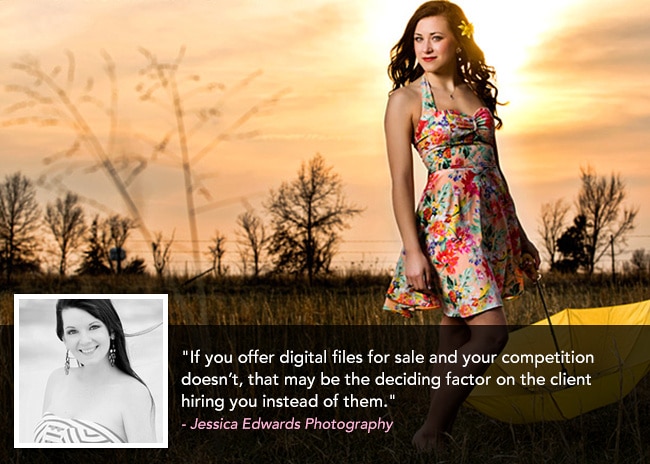Photographer’s Corner: How to Make Money Selling Digital Files
March 10th, 2014
In today’s digital world, where Facebook and Instagram are the modern day billboards, offering digital files on your price list only makes sense. But many photographers are still under the impression that selling digital files won’t bring in much profit. Others might not know how to market or sell these files. To shed some light on the subject, we asked four professional photographers how and why they offer digital files, and what it means for their business.
Lesson No. 1: Set order minimums 
Setting an order minimum will give you peace of mind that you aren’t working too hard for little to no profit. For equestrian photographer Shelly Paulson, a session fee and minimum order is required up front. “That minimum order is equal to my smallest digital collection, which includes eight files. Some clients aren’t interested in digital files, so they just use their minimum to order prints and products,” says Paulson.
Portrait photographer Jessica Edwards takes an all-or-nothing approach when it comes to selling digital files. “I offer digital collections that include all the images shown to a client. I choose not to sell only a few files. Clients either purchase all of them or none.”
 Lesson No. 2: Digital means instant gratification
Lesson No. 2: Digital means instant gratification
If you only offer prints for sale, those photos will not be seen by the masses. Digital files can be easily shared on the Internet through social media, email and blogs, resulting in many more eyes seeing your photos. This also doubles as advertising for your business, so the photos pay for themselves. “I think we are living in an age where people want those digital files for sharing and for archival purposes,” says Paulson.
Edwards also thinks it’s a great way to stand out from the competition. “If you offer them for sale and your competition doesn’t, that may be the deciding factor on the client hiring you instead of them,” she says.
Lesson No. 3: Advertise yourself as a printing guru
If you don’t offer print orders and only sell digital files, be the go-to print source. “I give my clients a license to print their images ONLY through Mpix, the consumer division of my professional lab, Miller’s Professional Imaging. I explain to my clients that Mpix is the only lab where I can guarantee they will get professional-quality images like I would if I ordered prints through my lab,” explains Edwards, who also prints 5×5 press cards with detailed instructions on how to use Mpix to order prints. “The extra time it takes me to help my clients who purchase digital files is built into my pricing.”
Lesson No. 4: Advertise yourself as a digital guru
Just like going through a reputable printing lab is necessary to get a quality print, so is going through a reputable photographer to get good quality digital photos. “Some people aren’t good at Photoshop or know how to resize files, so they often will purchase the Facebook resolution files we offer,” says Gene X Hwang of Orange Photography. “I personally love still having a tangible photograph, but the trend now is all digital.”
Lesson No. 5: Position digital as getting more bang for your buck
Buying digital files is good if the customer wants to print in bulk. “It’s good for a client if they want to print several copies of one file,” says senior portrait and boudoir photographer Erica Peerenboom. “Or if they are doing graduation or engagement announcements.”
Lesson No. 6: Digital sales can also lead to print sales 
Once clients receive their digital files, they may like them so much that they want to have a tangible print for their home. Paulson likes to include a print sample with every digital sale to get clients to act. She includes a 5×7 print for every digital file ordered. “I call these reference prints, so they know what good printing looks like. This way, if they print at a chain store, they will see the difference.”
Edwards also includes a print with each digital sale. “In my digital collections, I include a 4×6 print of each image,” she says. “The prints will serve as a standard for how the images should look once printed.”
Lesson No. 7: Price your files based on how much you want to make
Jessica Edwards is smart when it comes to setting her pricing: she sets the price of her digital files based on what she wants her average sale to be. “Once some clients purchase digital files, they may not buy much else from the photographer,” says Edwards. “For example, I want my average sale to be $2,000+ so I set my smallest digital collection for $2,400.”
Lesson No. 8: Make digital a necessity 
In today’s digital age, regular print doesn’t always cut it. “I think you have to think about them as complementary more than competitive since the world we live in now has much more digital sharing of images,” says Hwang. “I know there are folks who shoot and burn all the high-res files to DVDs, but instead of doing that, we have found that if you give people options that make sense, they will buy them.” And if you start offering video on your price list, people will be more inclined to purchase those as well.

Lesson No. 9: Price your digital files higher than prints
Because purchasing a digital file is more of a one-and-done transaction where people don’t have to purchase multiple copies, you can and should crank up the price. Peerenboom charges digital files at one flat rate. “It costs more for the digital file than the print but they can be printed as many times as they like forever,” she says.
Lesson No. 10: Digital offers more flexibility 
Digital files offer a number of advantages over prints. Printers run out of ink, packages contain a certain amount of prints, and it’s not easy to share one print with thousands of people. With digital files, you have the option to print or share your images as much as you want. “Clients can make unlimited small prints to give as gifts. I get paid more for the file than I would likely have made on small print sales,” says Paulson.
It’s a digital world, and photographers need to step up their business to meet the needs of a digital age. With the right business plan in place, photographers can easily make money offering this service. And the best part is — no printing is necessary.
We want to know: how have you handled digital sales differently in your photo business? Leave your answer in the comment section below.



